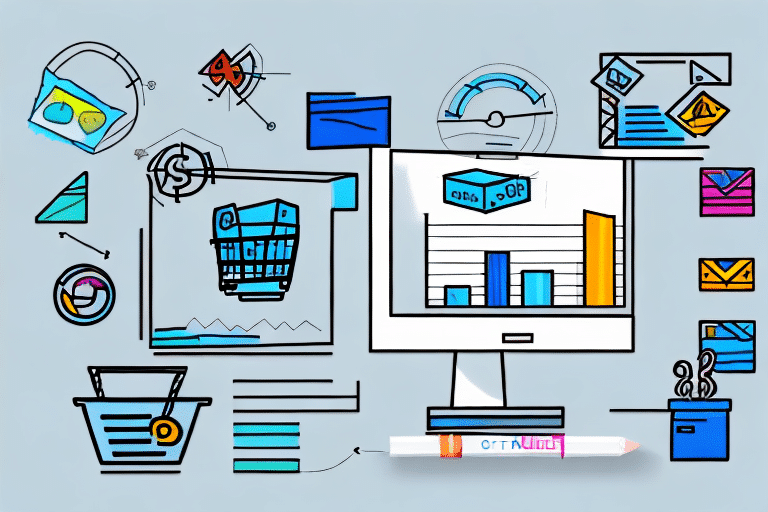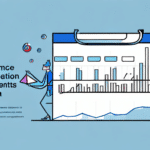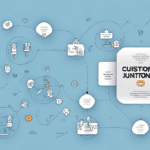Understanding Ecommerce Retention Metrics to Improve Customer Loyalty
As an ecommerce business owner, you are always looking for ways to retain customers and improve their loyalty to your brand. One of the most effective ways to achieve this is by understanding and measuring your ecommerce retention metrics. These metrics will help you understand how often customers are returning to your store and how much they are spending over time. By paying close attention to these metrics, you can create strategies to improve customer loyalty and increase their lifetime value (CLV).
Importance of Ecommerce Retention Metrics
Why Ecommerce Retention Metrics Matter for Customer Loyalty
When it comes to ecommerce, customer loyalty is essential for long-term growth and success. By retaining customers, you can reduce acquisition costs and increase revenue through repeat purchases and referrals. Ecommerce retention metrics help you understand how often customers return to your website and how much they spend on each visit. By monitoring these metrics, you can identify areas where you need to improve and create strategies to keep customers coming back.
The Importance of Measuring Ecommerce Retention Metrics for Your Business
Measuring ecommerce retention metrics is critical for any ecommerce business, whether you are a small start-up or an established enterprise. By understanding these metrics, you can gain insights into the effectiveness of your customer retention strategies and identify opportunities to improve. Measuring ecommerce retention metrics provides a realistic picture of how your online store is performing and helps you make informed decisions to grow your business.
One of the most important ecommerce retention metrics to measure is Customer Lifetime Value (CLV). This metric helps you understand the total value a customer brings to your business over the course of their relationship with you. By tracking CLV, you can identify your most valuable customers and tailor your retention strategies to keep them coming back. Additionally, measuring CLV can help you make informed decisions about customer acquisition costs and marketing spend, as you can determine the ROI of each customer.
Identifying and Tracking Key Ecommerce Retention Metrics
How to Identify the Right Ecommerce Retention Metrics for Your Website
There are several ecommerce retention metrics you can measure, but not all of them may be relevant for your business. The right metrics will depend on your goals, customer base, and industry. Some of the most common ecommerce retention metrics include:
- Customer Retention Rate
- Repeat Purchase Rate
- Average Order Value
- Customer Lifetime Value (CLV)
- Churn Rate
Conduct an analysis to identify the most relevant metrics for your business, and focus on measuring those.
One important factor to consider when choosing ecommerce retention metrics is the stage of your business. If you are a new business, you may want to focus on metrics that measure customer acquisition and conversion rates, rather than retention. As your business grows, you can shift your focus to retention metrics to keep your existing customers engaged and coming back for more.
Another factor to consider is the type of products or services you offer. For example, if you sell consumable products, such as food or beauty products, you may want to focus on metrics that measure repeat purchase rates and customer lifetime value. On the other hand, if you sell high-ticket items, such as luxury goods or electronics, you may want to focus on metrics that measure average order value and customer satisfaction.
The Top Ecommerce Retention Metrics You Need to Track for Customer Loyalty
It is crucial to track all the important ecommerce metrics to improve customer loyalty. Customer Retention Rate, which measures the percentage of first-time customers who return to the site over a specific period, should be a top priority. Additionally, Repeat Purchase Rate, Average Order Value, Customer Lifetime Value (CLV), and Churn Rate are essential metrics to measure. By tracking these metrics, you can identify areas where you need to improve and create strategies to keep customers coming back.
One important metric to consider is the Customer Acquisition Cost (CAC), which measures the cost of acquiring a new customer. By tracking this metric, you can determine if your marketing and advertising efforts are cost-effective and adjust your strategies accordingly. Another important metric is the Net Promoter Score (NPS), which measures customer satisfaction and loyalty. By asking customers how likely they are to recommend your business to others, you can gauge their overall satisfaction and identify areas for improvement.
It's also important to track customer engagement metrics, such as click-through rates, open rates, and conversion rates. These metrics can help you understand how customers are interacting with your website and marketing campaigns. By analyzing this data, you can optimize your website and marketing strategies to improve engagement and drive more sales.
Strategies to Improve Ecommerce Retention Metrics
How to Use Customer Data to Improve Ecommerce Retention Metrics and Boost Loyalty
Customer data can provide valuable insights into your customers' shopping habits and preferences. By analyzing this data, you can identify patterns and create targeted marketing campaigns to improve customer retention and loyalty. For example, if you notice that a specific customer purchases from your store frequently, you can personalize their shopping experience by offering them exclusive discounts or rewards. You can also use customer data to segment customers into different groups and create marketing campaigns that target each group with specific messaging that resonates with them.
Another way to use customer data to improve ecommerce retention metrics and boost loyalty is by analyzing customer feedback. By collecting feedback from customers, you can identify areas where your ecommerce store can improve and make changes accordingly. This can include improving the user experience on your website, offering more product options, or enhancing customer service. By addressing customer concerns and making improvements based on their feedback, you can increase customer satisfaction and loyalty.
The Role of Personalization in Improving Your Ecommerce Retention Metrics
Personalization is one of the most effective ways to improve ecommerce retention metrics and customer loyalty. By customizing the online shopping experience for customers, you can create a more memorable and engaging experience for them. You can personalize your marketing messaging, email campaigns, product recommendations, and even the website layout to cater to your customers’ preferences. Personalization can help increase customer satisfaction and build a stronger emotional connection with your brand, which can improve retention over time.
One of the key benefits of personalization is that it can help reduce cart abandonment rates. By providing customers with personalized product recommendations and offers, you can encourage them to complete their purchase and reduce the likelihood of them leaving items in their cart. Additionally, personalization can help increase the average order value by suggesting complementary products or upselling higher-priced items.
However, it’s important to note that personalization should be done in a thoughtful and strategic way. Overwhelming customers with too many personalized messages or recommendations can actually have the opposite effect and lead to them feeling bombarded or annoyed. It’s important to strike a balance and use data and customer feedback to inform your personalization efforts.
Strategies for Using Ecommerce Retention Metrics to Increase Customer Lifetime Value (CLV)
Increasing Customer Lifetime Value (CLV) is a crucial metric of customer loyalty in ecommerce. By measuring ecommerce retention metrics, you can create strategies to improve CLV. One of the most effective ways to increase CLV is by creating an excellent post-purchase experience. You can offer customers exclusive discounts and promotions for their next purchase, send personalized recommendations based on their past purchases, and enhance customer service by offering swift responses to their queries or concerns.
Another strategy for increasing CLV is by implementing a loyalty program. By offering rewards and incentives for repeat purchases, customers are more likely to continue shopping with your ecommerce store. This can include points-based systems, tiered rewards, or even exclusive access to new products or sales. Additionally, regularly communicating with customers through email newsletters or social media can help keep your brand top-of-mind and encourage repeat purchases.
Benefits and Best Practices
The Benefits of Improving Your Ecommerce Retention Metrics for Your Bottom Line
Improving ecommerce retention metrics has several benefits for your bottom line. By reducing customer churn and increasing Customer Lifetime Value (CLV), you can generate more revenue from existing customers, reduce marketing costs, and create a strong customer base that becomes advocates for your brand to others.
Additionally, improving retention metrics can also lead to valuable insights into customer behavior and preferences. By analyzing customer data, you can identify patterns and trends that can inform your marketing and product development strategies. This can help you tailor your offerings to better meet the needs and desires of your target audience, ultimately leading to increased customer satisfaction and loyalty.
Best Practices for Monitoring and Analyzing Your Ecommerce Retention Metrics
When it comes to monitoring and analyzing ecommerce retention metrics, there are several best practices you should follow to ensure you get the most out of the data:
- Regularly measure and track your metrics
- Set benchmarks and goals
- Compare your data to industry standards
- Invest in analytics tools and software that can help you measure and analyze your metrics more effectively
- Continuously refine your strategies based on the data
Addressing Common Challenges in Improving Your Ecommerce Retention Metrics
Based on experience, there are common challenges that ecommerce businesses face when trying to improve ecommerce retention metrics. Some of these challenges include:
- Insufficient data: Without enough data, it's difficult to make informed decisions. Ensure you have robust data collection processes in place.
- Lack of personalization: Generic experiences can lead to lower retention. Utilize personalization strategies to cater to individual customer needs.
- Not measuring the right metrics: Focusing on the wrong metrics can lead to misguided strategies. Identify and track metrics that align with your business goals.
By understanding these challenges and identifying solutions, ecommerce businesses can overcome these barriers and implement effective strategies to improve ecommerce retention metrics.
Case Studies and Conclusion
Case Studies: Examples of Businesses That Successfully Improved Their Ecommerce Retention Metrics
Many ecommerce businesses have achieved significant results by implementing strategies to improve ecommerce retention metrics. Case studies of these businesses provide practical insights and ideas that other ecommerce businesses can use to improve their metrics. Ecommerce businesses can learn from the best practices of these businesses and implement them to enhance their own ecommerce retention metrics.
Conclusion
Understanding and measuring ecommerce retention metrics is critical for improving customer loyalty and increasing Customer Lifetime Value (CLV). By learning and implementing the best practices discussed in this article, ecommerce businesses can create effective strategies to improve their retention metrics and generate more revenue in the long run.




















